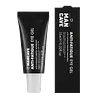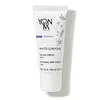What's inside
What's inside
 Key Ingredients
Key Ingredients

 Benefits
Benefits

 Concerns
Concerns

 Ingredients Side-by-side
Ingredients Side-by-side

Rosmarinus Officinalis Water
MaskingLz1 Peptide
Aloe Barbadensis Leaf Juice
Skin ConditioningGlycerin
HumectantTocopherol
AntioxidantWater
Skin ConditioningRosmarinus Officinalis Leaf Oil
MaskingHydrogenated Palm Kernel Oil
EmollientPEG-35 Castor Oil
EmulsifyingGlyceryl Stearate
EmollientPEG-100 Stearate
Cera Alba
EmollientCetyl Alcohol
EmollientCorylus Avellana Seed Oil
EmollientCamphor
MaskingSclerotium Gum
Emulsion StabilisingCarbomer
Emulsion StabilisingFagus Sylvatica Bud Extract
TonicTocopheryl Acetate 0.2%
AntioxidantBorneol
MaskingSodium Hydroxide
BufferingLavandula Angustifolia Oil
MaskingPelargonium Graveolens Leaf Oil
Cupressus Sempervirens Oil
MaskingThymus Vulgaris Flower/Leaf Oil
MaskingPhenoxyethanol
PreservativeChlorphenesin
AntimicrobialBenzyl Alcohol
PerfumingBenzoic Acid
MaskingLimonene
PerfumingLinalool
PerfumingCitronellol
PerfumingGeraniol
PerfumingCoumarin
PerfumingRosmarinus Officinalis Water, Lz1 Peptide, Aloe Barbadensis Leaf Juice, Glycerin, Tocopherol, Water, Rosmarinus Officinalis Leaf Oil, Hydrogenated Palm Kernel Oil, PEG-35 Castor Oil, Glyceryl Stearate, PEG-100 Stearate, Cera Alba, Cetyl Alcohol, Corylus Avellana Seed Oil, Camphor, Sclerotium Gum, Carbomer, Fagus Sylvatica Bud Extract, Tocopheryl Acetate 0.2%, Borneol, Sodium Hydroxide, Lavandula Angustifolia Oil, Pelargonium Graveolens Leaf Oil, Cupressus Sempervirens Oil, Thymus Vulgaris Flower/Leaf Oil, Phenoxyethanol, Chlorphenesin, Benzyl Alcohol, Benzoic Acid, Limonene, Linalool, Citronellol, Geraniol, Coumarin
Ingredients Explained
These ingredients are found in both products.
Ingredients higher up in an ingredient list are typically present in a larger amount.
Benzoic Acid is used to preserve and adjust the pH of products.
The antimicrobial property of Benzoic Acid helps elongate a product's shelf life. Its main role is to reduce fungi growth and is not found to be effective at fighting bacteria. Therefore Benzoic Acid is always added along with other preservatives.
In its pure form, Benzoic Acid looks like a white crystalline solid. It has slight solubility in water.
The name of Benzoic Acid comes from gum benzoin, which used to be the sole source of deriving this ingredient. Benzoic Acid is the most simple aromatic carboxylic acid.
Benzoic Acid is naturally occuring in strawberries, mustard, cinnamon, and cloves. It has a slight scent but is not considered to be a fragrance.
Learn more about Benzoic AcidCarbomer is a polymer of acrylic acid. Its main role is to create a gel consistency.
A high amount of carbomer can cause pilling or balling up of products. Don't worry, most products contain 1% or less of carbomer.
Glycerin is already naturally found in your skin. It helps moisturize and protect your skin.
A study from 2016 found glycerin to be more effective as a humectant than AHAs and hyaluronic acid.
As a humectant, it helps the skin stay hydrated by pulling moisture to your skin. The low molecular weight of glycerin allows it to pull moisture into the deeper layers of your skin.
Hydrated skin improves your skin barrier; Your skin barrier helps protect against irritants and bacteria.
Glycerin has also been found to have antimicrobial and antiviral properties. Due to these properties, glycerin is often used in wound and burn treatments.
In cosmetics, glycerin is usually derived from plants such as soybean or palm. However, it can also be sourced from animals, such as tallow or animal fat.
This ingredient is organic, colorless, odorless, and non-toxic.
Glycerin is the name for this ingredient in American English. British English uses Glycerol/Glycerine.
Learn more about GlycerinPhenoxyethanol is a preservative that has germicide, antimicrobial, and aromatic properties. Studies show that phenoxyethanol can prevent microbial growth. By itself, it has a scent that is similar to that of a rose.
It's often used in formulations along with Caprylyl Glycol to preserve the shelf life of products.
Sodium Hydroxide is also known as lye or caustic soda. It is used to adjust the pH of products; many ingredients require a specific pH to be effective.
In small amounts, sodium hydroxide is considered safe to use. However, large amounts may cause chemical burns due to its high alkaline.
Your skin has a natural pH and acid mantle. This acid mantle helps prevent harmful bacteria from breaking through. The acid mantle also helps keep your skin hydrated.
"Alkaline" refers to a high pH level. A low pH level would be considered acidic.
Learn more about Sodium HydroxideTocopherol (also known as Vitamin E) is a common antioxidant used to help protect the skin from free-radicals and strengthen the skin barrier. It's also fat soluble - this means our skin is great at absorbing it.
Vitamin E also helps keep your natural skin lipids healthy. Your lipid skin barrier naturally consists of lipids, ceramides, and fatty acids. Vitamin E offers extra protection for your skin’s lipid barrier, keeping your skin healthy and nourished.
Another benefit is a bit of UV protection. Vitamin E helps reduce the damage caused by UVB rays. (It should not replace your sunscreen). Combining it with Vitamin C can decrease sunburned cells and hyperpigmentation after UV exposure.
You might have noticed Vitamin E + C often paired together. This is because it is great at stabilizing Vitamin C. Using the two together helps increase the effectiveness of both ingredients.
There are often claims that Vitamin E can reduce/prevent scarring, but these claims haven't been confirmed by scientific research.
Learn more about TocopherolWater. It's the most common cosmetic ingredient of all. You'll usually see it at the top of ingredient lists, meaning that it makes up the largest part of the product.
So why is it so popular? Water most often acts as a solvent - this means that it helps dissolve other ingredients into the formulation.
You'll also recognize water as that liquid we all need to stay alive. If you see this, drink a glass of water. Stay hydrated!
Learn more about Water